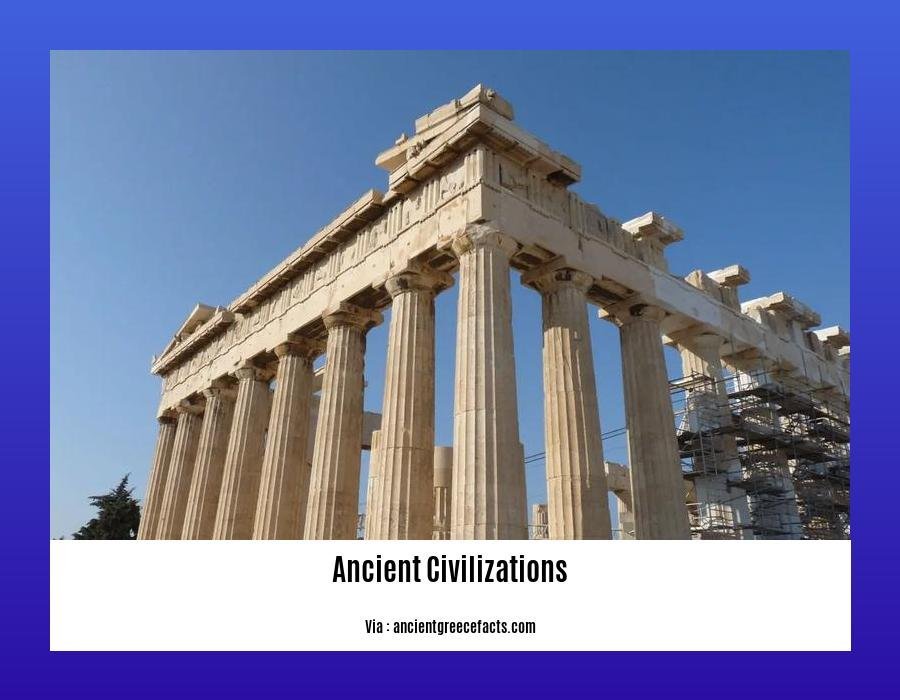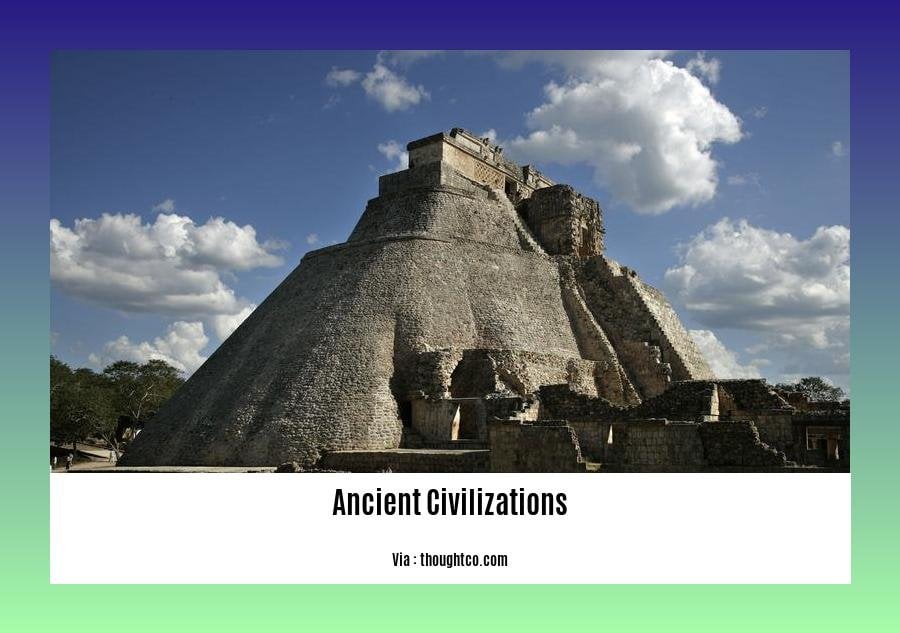Embark on a captivating journey through time and legacy with “Unveiling the Secrets of Ancient Civilizations.” Join us as we delve into the enigmatic ruins and decipher the mysteries of civilizations that once flourished, shaping the course of human history.
Key Takeaways:
- The San People hold the title as the oldest known civilization, tracing their existence back 140,000 years ago.
- Aboriginal Australians have preserved a unique culture in Australia for over 65,000 years, showcasing a rich oral tradition and artistic flair.
- Çatalhöyük stands as one of the first known cities, with its densely packed houses and advanced social organization.
- ‘Ain Ghazal, an early farming community, is renowned for its colossal limestone statues honoring their ancestors.
- Jiahu, a Neolithic site, gifted us with the qin, the oldest known musical instrument, and intricate pottery and jade carvings.
- Mesopotamia, the cradle of civilization, introduced writing through its cuneiform script and witnessed the rise of mighty empires.
- Norte Chico, the Americas’ oldest civilization, boasts impressive pyramids and temples, reflecting a structured society and advanced water management.
- The Indus Valley Civilization’s urban planning prowess is evident in cities like Harappa and Mohenjo-daro, featuring sophisticated sanitation systems and a standardized script.
Ancient Civilizations

We’ve dug deep into the soil of time to unearth the fascinating world of ancient civilizations. From the bustling metropolises of Mesopotamia to the enigmatic ruins of the Maya, these societies have shaped the course of human history.
Origins and Development
Ancient civilizations emerged as early societies transitioned to agriculture and urbanization. They thrived in diverse environments, from the fertile Nile Valley to the arid plains of Mesopotamia. Geographical factors, natural resources, and social structures played crucial roles in their development.
Major Civilizations
Let’s delve into some of the most influential ancient civilizations:
Mesopotamia: The birthplace of writing, Mesopotamia nurtured the Sumerian, Babylonian, and Assyrian empires. They left behind monumental ziggurats, cuneiform scripts, and advanced systems of astronomy and mathematics.
Egypt: The land of the pharaohs and pyramids, Egypt developed a centralized government, hieroglyphic writing, and impressive architectural feats. Their tombs and temples offer glimpses into their beliefs and social hierarchies.
Indus Valley Civilization:Flourishing in the Indus River Valley, this civilization planned cities with advanced drainage systems. They developed standardized weights and measures and traded extensively.
Chinese Civilization: With a rich history spanning millennia, Chinese civilization influenced philosophy, art, literature, and technology. The Great Wall and the Terracotta Army are testaments to their ingenuity.
Maya Civilization: Thriving in the jungles of Mesoamerica, the Maya developed a sophisticated calendar, hieroglyphic script, and remarkable mathematical and astronomical knowledge. Their towering pyramids and elaborate city-states showcase their architectural prowess.
Social Structures and Innovations
Ancient civilizations exhibited complex social organizations, including monarchies, empires, and city-states. Religious practices, ranging from polytheism to monotheism, played a central role in their societies. They made transformative innovations in writing, architecture, art, and technology that shaped human progress.
Writing: From cuneiform to hieroglyphics, ancient civilizations invented writing systems to record history, beliefs, and knowledge.
Architecture: Pyramids, temples, and city walls are tangible evidence of their architectural prowess. They employed sophisticated techniques and materials to create enduring structures.
Art: Ancient civilizations left behind stunning sculptures, paintings, and crafts. These artistic expressions provide insights into their aesthetics, beliefs, and everyday lives.
Decline and Legacy
The decline of ancient civilizations was influenced by various factors, such as environmental changes, warfare, and the rise of new empires. However, their legacies continue to inspire and inform us. Their achievements in science, art, and governance have laid the foundation for our modern world.
The study of ancient civilizations offers invaluable lessons about the human experience. They remind us of the ingenuity, resilience, and interconnectedness of our ancestors. By unraveling their secrets, we gain a deeper understanding of ourselves and our place in the tapestry of time.
If you are interested in world history, you should start reading the history of the world section, you will find major historical events like the world wars and others explained in detail, also to get a more detailed historical happening, go to the major historical events section. You may also want to take a look at our timeline of world events on the world history timeline page.
Social Structures and Innovations

Origins and Development:
Early human communities, once nomads, settled into agrarian life around 12,000 years ago. As agriculture flourished, so did populations, leading to the emergence of complex societies in urban areas known as cities or city-states.
Major Civilizations:
Civilizations blossomed in river valleys across the globe. Mesopotamia, Egypt, the Indus Valley, China, and the Maya developed unique characteristics, contributing to the tapestry of human knowledge.
Social Structures:
Ancient civilizations displayed a range of social structures. Monarchies, empires, and city-states governed the people. Religious practices, from polytheism to monotheism, shaped societal beliefs and behaviors.
Innovations:
Technological advancements and cultural achievements marked these civilizations. Writing, architecture, and art flourished. The invention of writing, for example, allowed for the recording of history and knowledge.
Decline and Legacy:
Environmental changes, warfare, and the rise of new empires contributed to the decline of ancient civilizations. Yet, their legacies endure in science, art, and governance, offering valuable lessons for humanity.
Key Takeaways:
- Human communities transitioned from nomadic to agrarian life, leading to the rise of complex societies.
- Ancient civilizations developed intricate social structures, including monarchies, empires, city-states, and religious practices.
- Technological innovations, such as writing, architecture, and art, marked the advancements of these civilizations.
- The decline of ancient civilizations holds lessons about environmental, political, and societal challenges.
- Understanding ancient civilizations deepens our appreciation for the ingenuity and interconnectedness of our ancestors.
Most Relevant URL Source:
- “Why Was Social Structure Important in Ancient Civilization?” by Fred Warner:
Decline and Legacy
From monumental achievements to poignant remnants, ancient civilizations have left an enduring mark on human history. Their rise, development, and decline offer valuable lessons for understanding our own civilizations today.
Factors Contributing to Decline:
- Environmental Changes: Climate shifts, natural disasters, and resource depletion could disrupt economies and lead to social unrest.
- Political Instability: Weak leadership, foreign invasions, and internal conflicts could fracture societies and undermine their stability.
- Overpopulation: Excessive population growth could strain resources and lead to conflicts over land and food.
- Technological Stagnation: Failure to adapt to changing technologies or invent new ones could put civilizations at a disadvantage.
Enduring Legacies:
Despite their decline, ancient civilizations have left behind profound legacies:
- Scientific and Technological Advancements: Writing, mathematics, astronomy, and engineering innovations have shaped our modern world.
- Artistic and Cultural Achievements: Art, literature, music, and architecture reflect the creativity and values of past societies.
- Social and Political Structures: Governments, laws, and social hierarchies established by ancient civilizations continue to influence modern society.
Key Takeaways:
- Ancient civilizations experienced cycles of birth, growth, and decline.
- Decline was often caused by a combination of environmental, political, and social factors.
- Despite their decline, ancient civilizations left behind enduring legacies in science, art, and social structures.
Citation:
“The Rise and Fall of Ancient Civilizations.” History of Yesterday, October 11, 2023.
Significance and Allure
The significance and allure of ancient civilizations lie in their profound influence on shaping human history and our collective consciousness. From the colossal pyramids of Egypt to the enigmatic ruins of the Mayan metropolis, these ancient societies offer a window into the ingenuity and resilience of our ancestors.
Origins and Development
Early human communities transitioned from nomadic existence to settled agrarian societies around 12,000 years ago. As populations grew and agriculture flourished, complex societies emerged in river valleys and fertile regions, leading to the formation of city-states and empires.
Major Civilizations
Throughout history, numerous civilizations have flourished and declined, each leaving an indelible mark on human civilization:
- Mesopotamia: Cradle of writing, astronomy, and mathematics.
- Egypt: Known for its monumental architecture, hieroglyphic script, and advanced irrigation systems.
- Indus Valley Civilization: Planned cities, standardized weights, and a sophisticated trade network.
- Chinese Civilization: Philosophy, art, the Great Wall, and technological advancements such as gunpowder and the compass.
- Maya Civilization: Calendar, hieroglyphics, mathematical knowledge, and impressive architectural achievements.
Social Structures and Innovations
Ancient civilizations developed intricate social structures, often with a ruling elite, a priestly class, and a workforce. Religious beliefs and practices played a significant role, with polytheism and monotheism shaping their worldviews. Moreover, innovations in writing, architecture, art, and technology transformed these societies and set the stage for future progress.
Decline and Legacy
While ancient civilizations reached great heights, they also experienced cycles of rise and fall. Factors such as environmental changes, warfare, and political instability contributed to their demise. Yet, the legacy of these civilizations endures through their contributions to science, art, governance, and the development of human culture.
Key Takeaways:
- Ancient civilizations were pivotal in shaping human history and cultural development.
- Their innovations and achievements continue to inspire and inform us today.
- The study of ancient civilizations provides valuable insights into our origins, values, and the human capacity for progress.
Most Relevant URL Source:
- Ancient Civilizations: Origins, Development, and Legacy
FAQ
Q1: What are the key characteristics that define an ancient civilization?
A1: Ancient civilizations are typically characterized by organized societies, complex social structures, the development of writing and record-keeping systems, and advancements in technology and infrastructure.
Q2: What are some of the earliest known ancient civilizations?
A2: Some of the oldest known ancient civilizations include the San People (c. 140,000 to 100,000 years ago), Aboriginal Australians (c. 65,000 years ago), Çatalhöyük (c. 7,500 BCE – 5,700 BCE), and ‘Ain Ghazal (c. 7,200 BCE – 5,000 BCE).
Q3: What factors contributed to the rise and fall of ancient civilizations?
A3: The rise of ancient civilizations was often driven by factors such as agricultural advancements, population growth, and the development of trade and commerce. Their decline could be influenced by various reasons, including warfare, climate change, environmental degradation, and overpopulation.
Q4: What are some of the most important legacies of ancient civilizations?
A4: Ancient civilizations have left a profound legacy on humanity, including advancements in science, technology, philosophy, art, and architecture. Their contributions have shaped the development of modern civilization and continue to inspire and inform present-day societies.
Q5: How can we learn more about ancient civilizations?
A5: We can learn about ancient civilizations through archaeological excavations, the study of historical texts and artifacts, and interdisciplinary research that combines archaeology, history, linguistics, and other fields.
- Unlocking Francis Alexander Shields’ Finance Empire: A Comprehensive Biography - July 12, 2025
- Unveiling Francis Alexander Shields: A Business Legacy - July 12, 2025
- Francis Alexander Shields’ Business Career: A Comprehensive Overview - July 12, 2025















